Is there really an electric future for Piaggio Aerospace?
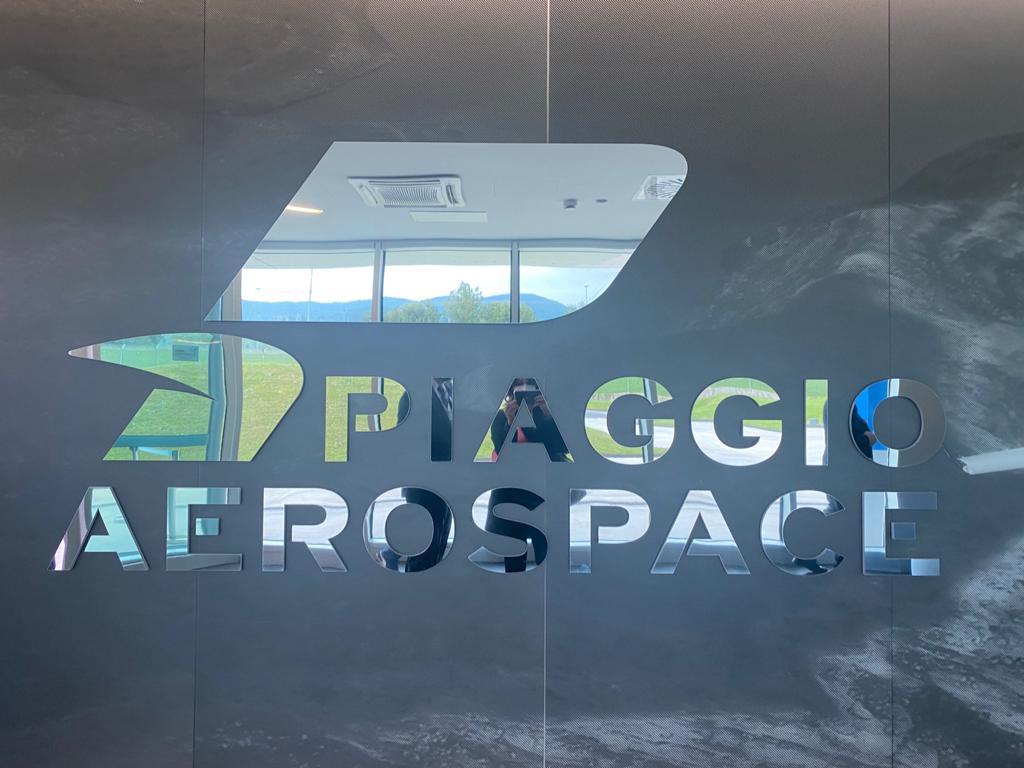
Facts, analyzes and scenarios on Piaggio Aerospace. The intervention of Paolo Mezzanotte, former director of Aermacchi, now freelance aeronautical designer
( This note was written some time ago, before the news about the substantial sinking of the negotiations to sell Piaggio Aerospace. For this reason some references may not be completely updated. But above all, the past time highlights the lack of an Italian line on the 'use (not just production) of hydrogen, in particular for aeronautical propulsion, a sector in which an investment looking to the future would be well justified. The proposed new program for Piaggio Aerospace, outlined here, would offer both a substantial opportunity market soon, is a precursor platform compared to any other known initiative, in view of the technologies, now in gestation, for hydrogen propulsion ).
In the recent history of world aviation there have been episodes of almost psychopathological interest and comparable to the gold rush, from which very few individuals emerged as winners (including several traffickers) while for the great mass it was a disaster. As a recent and striking example, one can recall the enormous amount of proposals and efforts that were spent, in the early years of the century, for the development of Personal Jet or Very Light Jet (VLJ) , stimulated by a joint FAA initiative- NASA (SATS) for personal transport aircraft and for air taxis. A vague memory of the plethora of development attempts of the time remains today.
From this adventure four models survive today (Phenom 100, Citation Jet M2, Cirrus Vision, Honda Jet) of which the last three, the most commercially successful (even if always relative), were developed almost ten years after the period of great ride.
A similar phenomenon, but on a much larger scale, is occurring today for electric propulsion applied to small airplanes, most of which fall into the vertical take-off category of Urban Air Mobility). The standard issued specifically by EASA in July 2019 (Doc. No: SC-VTOL-01) reports: "EASA has reviewed more than 150 VTOL project configurations, at different stages of maturity, all aiming at addressing a potentially new market." Electrification initiatives have increased and are increasing every day (those of which we have news today are well over 200, as can be seen from the following figure (Roland Berger, 2019 ): the great majority falls in UAM and General Aviation, but the ambitions grew progressively to include regional airplane projects as well as liners.
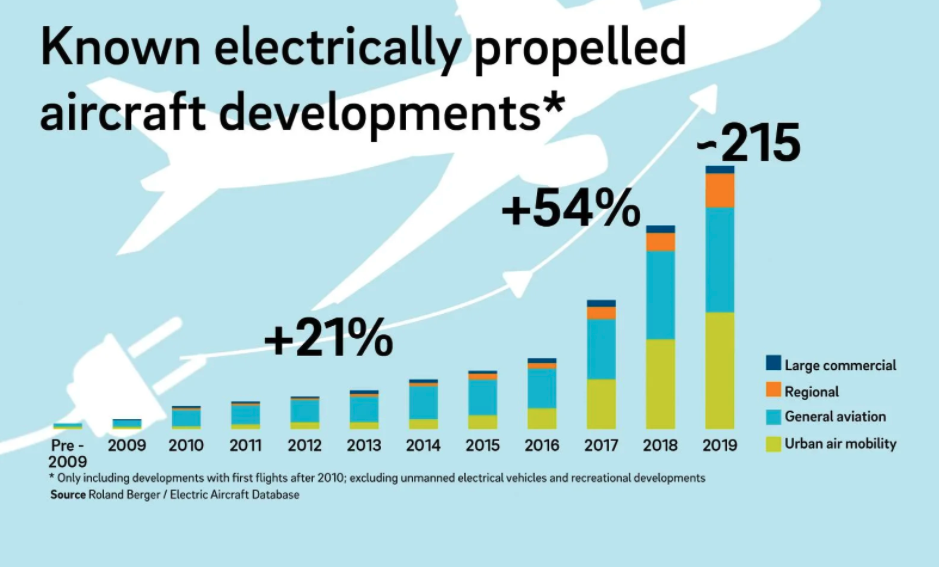
UAM's current projects have been critically examined in many papers, including one from last year with the emblematic title " Rotorcraft systems for urban air mobility: A reality check ", which ends with the sentence: "Many important problems are discounted by discipline specialists as trivial or obvious. The history of aviation demonstrates that Obvious is the father of all disasters. " It is worth considering whether a similar consideration can also apply to electric propulsion in general.
However, electric propulsion has now become the totem to which it appears retrograde to oppose critical evaluations. Key words such as "low carbon transport", "green aircraft", "disruptive" "innovative," paradigm shift in aviation "," sustainable transport "and even" zero emissions "are repeated, a statement whose validity must be verified in production at land of energy and systems that are then used in flight (here, of course, in a clean way). In short, as we read in the reference just mentioned, we are in a "New age of innovation", "It is not a question of if, but when".
The new forms of propulsion are not just a plant engineering theme but invest, and in a way that is radical is still little, the entire configuration project, aerodynamic, structural, of the interior spaces up to the payload capacity and range of the aircraft. Consequently, the promises of these new technologies – of course, very attractive – however require that the subject be treated with sufficient depth, with an overview, in a reasonable time perspective and foreseeing the necessary developments. It is perhaps not trivial to note that there are very different options, especially in the choice of the "energy tank": batteries, hydrogen, jet fuel for hybrid propulsion.
The topic is interesting in general but it is also of specific interest for Italy where, according to recent information , Piaggio Aerospace, one of the long-suffering historic aeronautical companies, could see its future in the development of a new hybrid aircraft or electric. On this point some basic questions arise spontaneously.
- A new technology alone can provide a starting point for access to research funding but does not justify a new development at all: a project is needed, that is a point of arrival, which demonstrates what advantages – operational, economic, market – can be offered over existing products. This arrival point, if this were the aircraft proposed in the article, would cost no less than 500 M € and not 80, as apparently alleged in the same article. A new technology can also give rise to a new market, but this must be well identified and demonstrated, especially in the face of the investment required just mentioned.
- The orientation towards a small regional aircraft is singular, given that the market for this class of aircraft has been practically non-existent for decades, as will be seen later (and the aircraft in service offer well over 1000 km of autonomy, a value entirely out of range from today's full electric, as will be seen later). The situation would be quite different if Piaggio's next program concerned a business jet, since Piaggio has already been present for decades in the business aircraft sector, a sector that is booming, with 700 jets sold every year for a amount of B $ 2, and which is showing considerable resilience even in the present time of profound aviation courses. According to our estimates based on sales data for the last 5 years, our proposal would lead to an annual turnover of no less than 500 M € for Piaggio.
- A new technology, in order to be used, must first be owned (ie it must be reliable and safe). We do not start with a new development thinking of developing the necessary technologies in the course of work, especially if it is a key element such as propulsion: it is not even possible to sensibly size a configuration. A serious project that uses electric propulsion, in any form, must be a piece of a technological development program, of which there are international and national examples in Europe, and must foresee times congruent with the maturation of the necessary technologies. For the European programs mentioned above, the time horizon is 15-30 years. (And even then it is not expected that the batteries will be able to reach the energy density necessary to sustain the flight with payload and ranges comparable to those obtainable with current propulsion systems.)
With simple common sense it seems obvious that the way to go is oriented to a new generation business jet, with design innovations that ensure it an absolute first place in the fierce range of competitors, therefore able to take – as soon as available – a consistent share of the rich market in the category. To start today, as is necessary, the project must be based on technologies and equipment that are certainly available in the short term, but it must also have such predispositions as to ensure the possibility of exploiting the new propulsion technologies (whatever the winners that emerge) that will mature. in the next 10-20 years. In this way, the airframe itself would provide the basis for long-term developments and could also serve, in the interim, as a test bed.
The proposal which was developed by a small team of designers (experienced and mature) that I represent is based on these principles. This, according to our line, is the path that should open the path of the future for Piaggio Aerospace also in the medium and long term. The issue is important for the company, for its territory, for the entire Italian aeronautics sector, which does not stand out for its presence in the civil sector. It can revitalize the P180 market: a buyer always wants to see a future in the supplier company. It is important for the company as a whole, which includes an engine division of great interest to many institutional operators (helicopters and the MB339s themselves).
The statements made above require substantiation and deserve further study. The following paragraphs are dedicated to these issues, with a method that probably would have liked Eng. Bazzocchi (who needs no introduction: “that of the MB”), who said “You have to convince Pierino too, and Pierino is me”. Among the infinite information available on propulsion electrification technologies, I tried to choose the useful ones and to present a perhaps elementary, incomplete, certainly perfectible, but global and usable picture.
ELECTRIFICATION OF CARS AND AIRPLANES
The enormous success of the race to electrification of motor vehicles is there for all to see, every day. The underlying philosophy expounded, many years ago, by Elon Musk was and still remains valid, from the point of view of energy saving (it is absent from the reasoning of the article, but it could perhaps be included, the issue of emissions, which must be seen on a global scale , including the energy and systems production phase). In the automotive field, energy storage is obtained with batteries, although studies have been carried out for the use of hydrogen-powered fuel cells. A key point, again in this field, is the recovery of braking energy, which makes consumption lower on the urban route than on the motorway. The central point in favor of batteries, well highlighted in Musk's paper cited above, is the possibility of obtaining a much better yield of ground energy generation than any traditional (thermal) automotive engine: it follows that the quantity of TOTAL energy required for a certain energy USEFUL for movement is less for batteries than for fuel. The success of the formula is undoubted and the urban use of electric cars is growing: all the taxis I have seen recently in Amsterdam are Tesla (but the Prius had already spread, before, almost everywhere). Thus, Tesla has come to have a capitalization equal to 100 times the Rolls Royce aircraft engines, thanks to the macroscopic management errors of this company.
The use of this technique for aviation has obvious differences. There is no recovery of braking energy and the batteries, despite continuous but slow progress, have an enormous weight: to date, the specific energy of a lithium battery (250 Wh / kg ≈ 0.9 MJ / kg) it is almost 50 times lower than that of jet fuel (43 MJ / kg). Considering the efficiency of an electric motor, with the relative system and the propeller or a fan, and that, much lower, of a system that includes a heat engine, the ratio between "useful" energies is less than 20. This information has now reached the generalist (aeronautical) press, where an issue by Elon Musk that provided for the overtaking of the kerosene batteries to reach 400 Wh / kg, perhaps expected for 2035, was contested with excellent arguments .
It is certainly true, as Musk's note demonstrates, that batteries offer the best energy-saving solution out there. But the "hard facts" that limit its use, in aviation, as only "energy reservoir" can be summed up in one word: weight.
Any aeronautical project has weight as an essential parameter, on which feasibility and survival depend; in any healthy project, weight containment is seen as an absolute necessity for the mission and for the very ability to get up from the ground. An “overrun” of the target weight has led to the cancellation of countless projects in the history of aviation. Let's see first a known reference: the Tesla 3 has, of all models, the lightest batteries for the “long range” case (500 km declared); their energy density is 150 Wh / kg, weight 480 kg, volume 400 liters. Even considering options with much more performing batteries, as indicated in the previous paragraph, an aircraft that today carries 2500 kg of jet fuel (typical value for an average business airplane or a small regional one) should carry 40 tons of batteries. With the progress predicted by the same sources cited above, in 15 years “only” 27 tons would be enough and in 30 years, perhaps, “only” 6000 kg with new type batteries such as Li-air (not to mention the volume). The implications for the project are more than evident and it is useless to waste time. (In fact, it is obvious and intuitive that every increase in the weight of the airplane involves the resizing of the structure, of the plants, of the fuel to maintain its mission capabilities: whoever chews the rudiments of design knows the "growth factor" of project texts , from Roskam to Raymer etc. Not to mention that, today, the weight of each airplane is reduced during flight, and this significantly affects consumption, while with batteries the weight remains constant and in the future, with Li- air, it could even increase in flight). In summary: using batteries as the only energy reservoir, autonomy must necessarily be very limited for a minimally realistic project. This is why most of the initiatives in this sector are aimed at urban transport (UAM) or very short missions from General Aviation, often for training . This category includes the Airbus E-Fan project whose production was planned, which was then canceled because Airbus decided to devote itself to a much more ambitious hybrid regional aircraft solution.
THE MOST AMBITIOUS PROJECTS OF ELECTRIFIED AIRPLANES
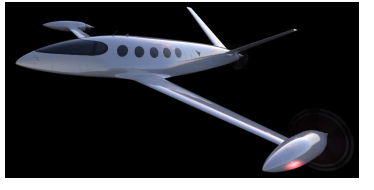 Leaving now the UAM field aside to take a look at the higher class projects, there is a great variety of proposals, only some of which are shown in the following figures, to attempt some broad evaluation. There are basically two categories of propulsion systems: the full electric ones with batteries (many with engines divided between several engines) and the hybrid ones. Of the first system, it was said above. There are countless initiatives in General Aviation , with generally very limited autonomy. The Magni-X initiatives belong to a higher class; the achievements presented so far are retrofits of existing airplanes, limited to very short journeys (15-60 min, 160 km) with substantial improvements expected in the coming years. The most ambitious MagniX program (which also plans to develop hydrogen systems on its site) is Eviation Alice , which promises 440 nm range for 9 passengers, using 3600 kg of batteries (60% of the take-off weight; of 260 Wh / h Li-ion type). The first flight was scheduled for 2019 but the prototype was destroyed by fire in January 2020. A new prototype is under construction. The very recent French initiative of Aura also falls into this category: a regional aircraft with 19 seats, which relies on "specially-developed batteries", is supported by 3-5 million from the Occitania Region and whose first flight is expected in 2024 and entry into service in 2026.
Leaving now the UAM field aside to take a look at the higher class projects, there is a great variety of proposals, only some of which are shown in the following figures, to attempt some broad evaluation. There are basically two categories of propulsion systems: the full electric ones with batteries (many with engines divided between several engines) and the hybrid ones. Of the first system, it was said above. There are countless initiatives in General Aviation , with generally very limited autonomy. The Magni-X initiatives belong to a higher class; the achievements presented so far are retrofits of existing airplanes, limited to very short journeys (15-60 min, 160 km) with substantial improvements expected in the coming years. The most ambitious MagniX program (which also plans to develop hydrogen systems on its site) is Eviation Alice , which promises 440 nm range for 9 passengers, using 3600 kg of batteries (60% of the take-off weight; of 260 Wh / h Li-ion type). The first flight was scheduled for 2019 but the prototype was destroyed by fire in January 2020. A new prototype is under construction. The very recent French initiative of Aura also falls into this category: a regional aircraft with 19 seats, which relies on "specially-developed batteries", is supported by 3-5 million from the Occitania Region and whose first flight is expected in 2024 and entry into service in 2026.
In the same category belongs the Heart Aerospace initiative whose project, although clearly embryonic, promises to bring 19 passengers at 400 nm in 2026. Certainly 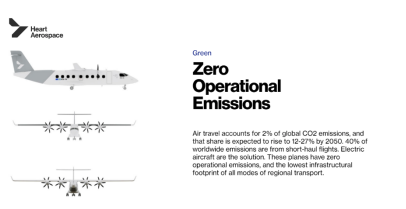 other initiatives will follow, whose Achilles' heel will always be the very low autonomy obtainable with a plausible load of batteries; and in fact, even these projects are often dedicated to communications in metropolitan areas.
other initiatives will follow, whose Achilles' heel will always be the very low autonomy obtainable with a plausible load of batteries; and in fact, even these projects are often dedicated to communications in metropolitan areas.
It is important to note that the market for this segment of small regional aircraft with a maximum of 19 seats (the existing ones offer ranges of at least 1200 km) has been dead for decades, as shown in the following figure. Given the continuous increase in initiatives in this field, it is difficult to escape the impression that these companies are propelled by the emotional wave of the moment, in which the transition to renewable energy announced by several governments is mistaken for an Eldorado, without the necessary insights.
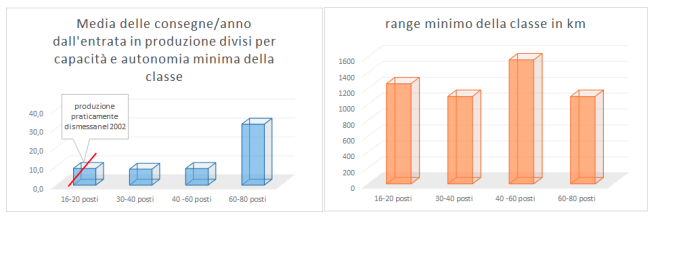 Other projects rely on hybrid solutions, with a heat engine that generates energy for electric motors and batteries in limited quantities, only for certain phases of flight. Here it seems that the project must necessarily rely on the advantages deriving from the sizing of the heat engine for the cruise alone, entrusting the electrical system with the management of the additional power necessary for the terminal phases and the ascent. In this case, the presence on board of jet fuel can still provide sustained autonomy.
Other projects rely on hybrid solutions, with a heat engine that generates energy for electric motors and batteries in limited quantities, only for certain phases of flight. Here it seems that the project must necessarily rely on the advantages deriving from the sizing of the heat engine for the cruise alone, entrusting the electrical system with the management of the additional power necessary for the terminal phases and the ascent. In this case, the presence on board of jet fuel can still provide sustained autonomy.
There is an illustrious victim in the sector: the fully electric Zunum regional airplane, which was designed  for trips “to a thousand miles” and which had also had the support of Boeing, it stopped its activities and fired the entire staff due to lack of funding after the initial ones (a few tens of M $). Hybrid propulsion with the GE Catalyst engine has the Trifan , halfway between UAM and regional transport, with extraordinary capabilities (vertical take-off, 6 seats, 1200 nm range with conventional take-off) and technologies (FBW controls, carbon structure, Embedded Solar Film for ground power, Full Airframe Parachute). Difficult to judge its realism, with the limited data available (for example, no weight data). The latest news dates back to 2019, when a 65% scale model took off in bound flight and the engine was subsequently chosen for the series.
for trips “to a thousand miles” and which had also had the support of Boeing, it stopped its activities and fired the entire staff due to lack of funding after the initial ones (a few tens of M $). Hybrid propulsion with the GE Catalyst engine has the Trifan , halfway between UAM and regional transport, with extraordinary capabilities (vertical take-off, 6 seats, 1200 nm range with conventional take-off) and technologies (FBW controls, carbon structure, Embedded Solar Film for ground power, Full Airframe Parachute). Difficult to judge its realism, with the limited data available (for example, no weight data). The latest news dates back to 2019, when a 65% scale model took off in bound flight and the engine was subsequently chosen for the series.
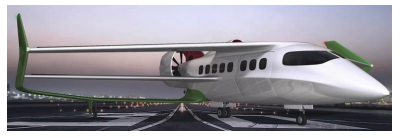 Also British is Faradair , which offers an 18-seat aircraft with an aerodynamic configuration with a “triple box wing”. The announcement is from last year. The project derives from a full electric in 2014 and the first flight is expected in 2026. Very few data are available.
Also British is Faradair , which offers an 18-seat aircraft with an aerodynamic configuration with a “triple box wing”. The announcement is from last year. The project derives from a full electric in 2014 and the first flight is expected in 2026. Very few data are available.
The design of a hybrid commercial airplane was recently revealed: the EAG's 70-seat British regional , which 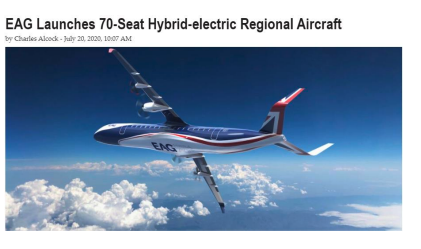 plans to fly in 2024 with a program cost of 5 B £ st. The designers arrived at the hybrid solution after noting that a 20-seat battery-powered aircraft would realistically have a range of a handful of kilometers : “you can't fly a meaningful distance”.
plans to fly in 2024 with a program cost of 5 B £ st. The designers arrived at the hybrid solution after noting that a 20-seat battery-powered aircraft would realistically have a range of a handful of kilometers : “you can't fly a meaningful distance”.
The United Kingdom appears to have a serious investment and research plan in the field of hybrid propulsion aiming for an industrial outcome in 2030-2040, as seen by the EU FutPrint program , in which Cranfield University, the British university reference for this activity .
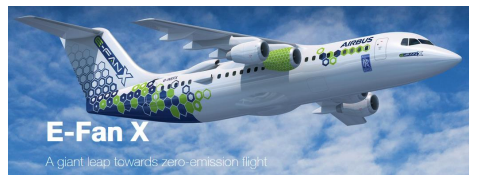 However, a recent Airbus decision deserves reflection. As indicated above, Airbus had launched, with Rolls Royce and Siemens, an ambitious demonstrator called E-Fan X : a BAe146 (the "Jumbolino") in which one of the four motors was replaced by a fan driven by a Siemens 2 electric motor. MW, in turn powered by a turbine heat engine and a 2000 kg battery pack . This demonstrator was supposed to fly in 2021, but the program was stopped in April 2020. The reason is Airbus' strategic orientation towards the use of hydrogen as a future source of energy for the propulsion of its airplanes. To confirm and clarify this decision, Airbus has coordinated a broad overview in which ideas on future Airbus platforms of each category are presented, from the 19-seat airplane to the 80-seat regional aircraft (obviously seen as a substitute for the ATRs) up to the liners. large; in particular, “H2-powered commuter, regional, and short-range aircraft could be commercially available in the next 10-15 years.
However, a recent Airbus decision deserves reflection. As indicated above, Airbus had launched, with Rolls Royce and Siemens, an ambitious demonstrator called E-Fan X : a BAe146 (the "Jumbolino") in which one of the four motors was replaced by a fan driven by a Siemens 2 electric motor. MW, in turn powered by a turbine heat engine and a 2000 kg battery pack . This demonstrator was supposed to fly in 2021, but the program was stopped in April 2020. The reason is Airbus' strategic orientation towards the use of hydrogen as a future source of energy for the propulsion of its airplanes. To confirm and clarify this decision, Airbus has coordinated a broad overview in which ideas on future Airbus platforms of each category are presented, from the 19-seat airplane to the 80-seat regional aircraft (obviously seen as a substitute for the ATRs) up to the liners. large; in particular, “H2-powered commuter, regional, and short-range aircraft could be commercially available in the next 10-15 years.
HYDROGEN IN FUTURE AVIATION: TODAY'S VISION
The use of hydrogen as an energy reservoir for certain on-board systems has been under consideration for a long time , but for aeronautical propulsion it presents very important and particular aspects. Naturally, there is talk of using it not for combustion, whose thermodynamic efficiency would be very low, but to generate electricity directly, with fuel cells. Almost all of the world's hydrogen production uses non-renewable sources , but the production of “clean” hydrogen could rapidly approach .
Meanwhile, the specific energy of hydrogen (120 MJ / kg) is almost triple that of jet fuel. Unfortunately, its density is very low and must be increased either with compression (GH2, usually proposed at 700 bar) or with liquefaction (LH2, at a temperature of about -250 ° C) or with both, "cryocompressed" (CcH2 ). These solutions are not painless. The weight of the tanks (designed for pressure and / or very low temperature) is always greater – if not much greater – than that of the content. In the case of liquid hydrogen, liquefaction on the ground involves considerable consumption, while in flight, by deducting that of liquefaction, the available energy is reduced by more than a third, plus the losses related to the fact that boil-off , which necessarily occurs in tanks that are not completely adiabatic, does not always correspond to the quantity necessary for propulsion. But, even if compressed or liquefied, the density of hydrogen remains very low compared to jet fuel and requires a much higher volume of the tanks (roughly 4 to 8 times greater for the same energy). In summary, hydrogen is an extremely attractive energy source for its energy content, for environmental cleanliness, for its abundance in nature (even if always in combination with other elements). But its use requires knowledge and technologies not yet fully acquired and design criteria not applied for the aircraft in use today.
The most basic, but here perhaps most effective, way of assessing the potential of hydrogen for aviation is to size (spannometrically) a future propulsion system with this new technology and compare it with a current system. For a meaningful comparison, it will be necessary, as already done above for the case of batteries, to obtain at the end the same useful energy, for propulsive purposes, of an average business airplane or a small regional aircraft that today embark 2500 kg of jet fuel.
The new propulsion system considered therefore includes hydrogen with related tanks, fuel cells, the electricity distribution system, a minimum set of batteries to manage at least emergencies, motors and fans. The evaluations that follow are completely gross, but the orders of magnitude that come out of them can hardly leave doubts.
A preliminary consideration, again for an average business airplane or a small regional one: the efficiency of today's propulsion systems (jet or propeller), which use jet fuel, understood as the ratio between the useful power (= traction x speed) and energy content of the fuel is not far from 20%. This indicative data can be easily obtained from the manufacturers' data, weighing the various flight conditions. If the same calculation is carried out for a hydrogen-based system, an efficiency is obtained roughly double, referring naturally to the available energy (which, as mentioned above, is lower for liquid hydrogen). Obviously, this is not an immutable result but it is a function of the technology used (component performance), which will certainly improve over time.
From these better yields it derives that, for the same useful energy, the energy to be loaded in the form of hydrogen is less, compared to jet fuel. The weight of the necessary hydrogen (which, remember, has a very high specific energy) is therefore much less than jet fuel.
Unfortunately, however, there are negative aspects: the weight of the tanks (although very different for compressed and liquid hydrogen) reverses the previous conclusion, at least with today's technology: the hydrogen "system" plus the tank weighs more than the " system ”jet fuel plus tank. But research activities in this field, as in the field of systems necessary for hydrogen propulsion (fuel cells, motors, inverters, distribution, obviously batteries) are in great ferment. The available forecasts configure a wide range of scenarios, also summarized in university theses (see thanks below) and perhaps more realistic data are provided and used in the aforementioned Airbus publication . They all agree that in the space of 15 years, progress will be such as to give hydrogen-based systems an advantage.
From this picture, the widely shared conclusion clearly emerges that the technology available in 2035 will make it possible to build hydrogen propulsion plants weighing no more than today's plants, which use jet fuel, and with a lower energy consumption, of course. equal useful energy available for propulsion purposes. They are already underway 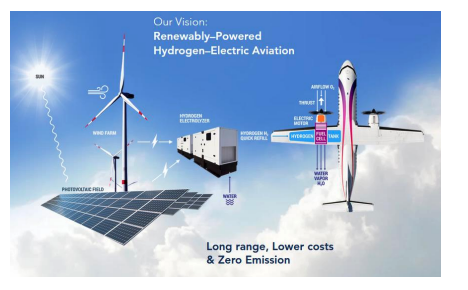 experimentation initiatives, such as the Zeroavia , of this system in flight, initially using existing platforms. The figure opposite, copied from the company's website, illustrates the long-term vision. It remains, however, to take into account the aspect of the necessary volume, which in the case of hydrogen propulsion is always much greater and such as to reasonably preclude any attempt to convert (if not, perhaps, with limited objectives for experimental purposes) existing cells. In other words, the use of hydrogen will necessarily lead to projects with new and different forms and solutions from the current ones.
experimentation initiatives, such as the Zeroavia , of this system in flight, initially using existing platforms. The figure opposite, copied from the company's website, illustrates the long-term vision. It remains, however, to take into account the aspect of the necessary volume, which in the case of hydrogen propulsion is always much greater and such as to reasonably preclude any attempt to convert (if not, perhaps, with limited objectives for experimental purposes) existing cells. In other words, the use of hydrogen will necessarily lead to projects with new and different forms and solutions from the current ones.
At the conclusion of these extremely concise, and necessarily superficial, considerations on electrification in aviation, one cannot fail to note that, whatever the path one wishes to undertake in the future, in order to arrive at credible projects, decisive steps forward are needed compared to what available today: typically in the specific energy of batteries, in the efficiency of the motors (which must also be very high to avoid major problems of heat dissipation), in the efficiency of fuel cells, in the design of cryogenic and / or very high pressure tanks , in the generation and distribution of large electrical powers which necessarily involve very high voltage.
No consideration was given to safety aspects, to logistical and infrastructure aspects, to everything concerning the production and use of the necessary energy on land, as well as to the evaluation of gaseous emissions and perhaps aspects linked on the one hand to extraction. and the use of fossil fuels, on the other hand to the rare earths necessary for electrification: absolutely vital issues, to which, however, in an article like this – already too long even if focused only on the possible form of "things to come" – does not you can not even mention it.
THE FUTURE OF PIAGGIO AEROSPACE
The considerations set out so far deserve to be applied to the very hot case of Piaggio Aerospace, whose troubled sales process is drawing to a close, under the management of the commissioner.
On the subject, I would first like to refer to the previous December article on the same topic , in which I was trying, obviously as an external observer, to outline a path for the recovery of the company, which involved returning to its elective line of business airplanes: a theme for which Piaggio has the skills, a market in which it has already (had) a position and which, as can be deduced from the panorama that is there for all to see, can give great satisfaction to the companies that manage to stay there. In this context it was clearly necessary to envisage a new product, which the design team I am part of identified and designed, at a conceptual level: a radically innovative business jet, designed to emerge already with current technologies but prepared, like no existing aircraft. , for the future.
A recent stance by one of the consortiums vying for the purchase emphasizes electrification as a qualifying point for the development of a new small regional airplane that is proposed as the future flagship product of Piaggio. On this issue I would like to propose some considerations, also linked to what has been said in the previous paragraphs.
Meanwhile, some preliminary considerations on the category of regional aircraft. I repeat here what has already been indicated in a previous paragraph. The market is almost completely absorbed by the 60-80 seat category and that of the "small" regional ones (up to 19 seats can be certified according to Part 23 of the FAA and EASA) is almost non-existent: after the cessation of production of Beech 1900 and Jetstream practically, only Do228 remains (in India). Another interesting theme is autonomy which, for all classes, is on average between 1100 and 1500 km. Now, as demonstrated above, for autonomies such as current or expected medium-term ones, the weight of the batteries is completely prohibitive and it is necessary to fall back on much lower values. Each alternative – those under study are hybrid or hydrogen propulsion – requires a long-term research plan, like the one that is taking shape in the UK , but with an eye to at least 2035. Not, therefore, with available technologies, not with immediate development. The appearance of a new technology, still largely to be developed, alone does not justify a development and does not give a future to a company looking for a role, if not – precisely – with a reasonable time horizon, in this case of at least 15 years, as for the aforementioned British or Airbus programs (and after having ascertained the reasons why a market, such as that of small regional aircraft, which has been stopped for twenty years, should restart with a new airplane, however innovative) . Any claim to reach an industrial outlet in a short time and / or without a precise research plan and development of the necessary technologies is illusory.
The market situation of business aircraft, in which Piaggio is present, and in particular of jets, is quite different from that of small regional ones.
The following graphs show deliveries and turnover and speak for themselves: even in the light / mid size category alone, sales are in the hundreds per year, revenues are in the order of 2 B $ per year and the market is resilient: that is, it does not show the collapse in sales that has largely occurred in commercial aviation.
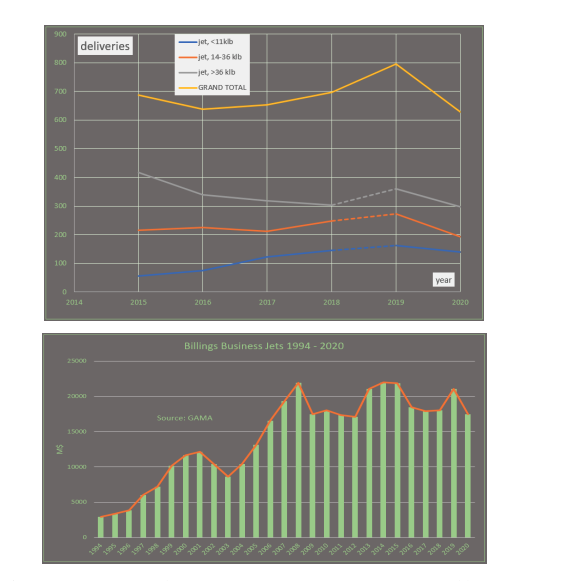
Piaggio Aerospace has tried, in the past, to enter this extremely profitable field, but without success.
Today, in particular, one can enter the club – which is crowded with experienced and established actors – only with a well-conceived and forward-looking program.
Another consideration is important: the irruption of a new technology, even a disruptive one, does not involve the reduction of attention in traditional project fields . When the Fly By Wire flight controls became available, not for this reason (despite the opinion of some poorly lit colleagues) the care of the aerodynamic project diminished. In the same way, the success of a new project, also intended to employ an innovative propulsion system, must present characteristics of innovation and superiority in the airframe: aerodynamics, structures, habitability; even more so in the presence of a crowded and aggressive – but very profitable – market such as that of business jets.
The idea of the team I represent, as already outlined in the previous article , consists precisely in the project of a radically innovative business jet configuration also in the layout that takes into account the increasingly stringent environmental rules and aims at absolute market superiority. Qualifying points are a very rational structural architecture, with weight advantages, superior aerodynamic efficiency, an unparalleled level of habitability and comfort; finally, the availability and location of volumes that make the transition to new hydrogen-based propulsion systems possible, when they become available. With this, Piaggio could have a new airplane leader in its class, already with current technologies, immediately after development, and ready to take advantage, without radical changes to the airframe, of the new propulsion systems planned for 2035.
Naturally, a development of this magnitude certainly has a not modest cost, well beyond the 80 M € of the Recovery Plan . The cost of developing and certifying a medium business jet is of the order of 500 M € (or higher, if development of non-current technologies were necessary), not unlike what a small regional airplane would require. But, unlike the small regional for which, as we have seen, the market has been almost non-existent for decades, an outlet in the business jet market with the right aircraft would ensure, according to our estimates based on sales data for the last 5 years, an annual turnover does not less than 500 M € and would also have two effects that are certainly not secondary: revitalize the P180 market, which would remain stagnant if the manufacturer did not show signs of vitality, and also reassure, about the future of the company, the customers of the engine division (many institutional , helicopter operators such as MB339) about the future. The ability, guaranteed by the project, to give rise to even more innovative future versions would not only open a window to the future but would immediately be an element of attraction.
Piaggio Aerospace deserves to have confidence and then walk on its own legs. The recent example of the nearby Pilatus (where there is an important presence of Italians also in the design) is a demonstration of what Piaggio could also achieve.
**********
Thanks. I owe a debt of gratitude to prof. Trainelli, of the Politecnico di Milano / DAER and his colleagues, who have always been very active in the field of aircraft design with innovative propulsion solutions. The theses and publications of the Poli, as well as a thesis of the TUM of Munich, and the related bibliographies, have provided me with much of the information I needed for this note. Of course, only mine is the responsibility of the statements and any errors.
Note: the links in the article, which are intended only to point to examples of what is available on the net, are active at the time of writing but the content of some articles may change, as is understandable given that the subject matter is attractive and evolving tumultuous.
This is a machine translation from Italian language of a post published on Start Magazine at the URL https://www.startmag.it/smartcity/ce-davvero-un-futuro-elettrico-per-piaggio-aerospace/ on Tue, 28 Sep 2021 06:19:46 +0000.
